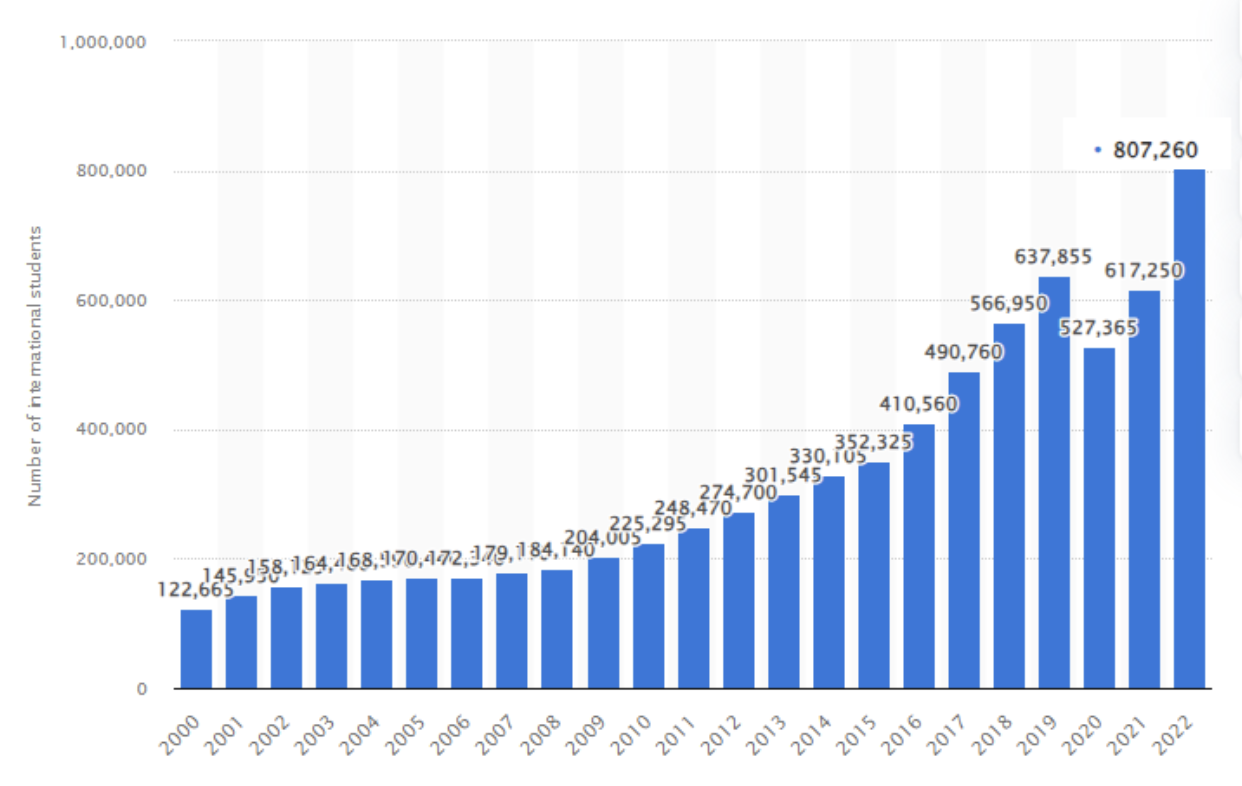Canada rolls out the red carpet for over 400,000 foreign students every year. And politicians and business leaders point enthusiastically at the impressive GDP growth figures that stem from the rising international enrolment in our education system.
Because why bother creating truly sustainable opportunities when temporary tuition dollars will do?
And who cares if the thousands of students are being used in the process?
The reality is that Canada uses foreign students to boost it’s GDP numbers and it’s becoming far too reliant on international enrolments to grow a fading economy on the backs of thousands of foreigners.
This article will closely examine how Canada uses international students for GDP growth. It will also discuss the challenges of relying on them too much and how if you’re in the process of looking to come to Canada, you may want to take our Leaving Canada Quiz to see if you belong elsewhere!
The Statistical Mirage: International Students and GDP
At face value, the impact of international students on Canada’s GDP is real and helping grow the economy.
According to Statistics Canada, foreign students accounted for 1.8% of total GDP in 2019, with significant contributions to industries like accommodation and food services (7.5%), private education (6.5%), and retail trade (1.3%).
This amount is more than the exports of wheat, lumber, or aircraft, which are some of Canada’s traditional industries.

Moreover, international students supported about 170,000 jobs in 2022. And projections indicate they are expected to contribute $28.6 billion in 2024.
However, the impact of international students on the economy is also not entirely positive, as it may have negative consequences for domestic students, new immigrants outside of the education sector, and the Canadian society at large.
One of the consequences is the crowding out effect, which occurs when the increased demand for education by international students reduces the availability or quality of education for domestic students.
According to a study, the enrollment of international students in Canadian universities increased by 88.5% in recent years, while the enrollment of domestic students increased by only 22.6%.
This means that the growth in the number of international students was much more than the growth in the resources available for education, like teachers, facilities, and money.
Because of this, the study discovered that there are more students for each teacher (the student-faculty ratio increased by 9.5%), and classes got bigger (average class size increased by 12.2%) during the same time. So, there are more students, but not enough extra resources to support their education.
These indicators suggest a deterioration in the quality of education and the student experience for both domestic and international students.
Predatory Exploitation – How Canada Uses Foreign Students for GDP Growth
Canada uses various policies to attract international students to fuel it’s declining GDP growth.
- Through the Express Entry immigration system, candidates who have a job offer or a post-secondary degree from Canada get extra points for permanent residency.
- The Post-Graduation Work Permit Program enables international graduates to work in Canada for up to 18 months and gain Canadian work experience.
However, these policies are often exploitative.
Canada’s heavy reliance on international students raises ethical concerns. As numbers rise amid a competitive global market, issues have come to light:
- High Tuition Fees: International tuition fees make education in Canada one of the most expensive in the world. On average, international students pay over three times more than domestic students. Despite the appeal of Canadian education—the financial burden on international students is substantial. High tuition fees often lead to financial strain and create a cycle of unsustainable debt. And let’s unpack that. Even if a foreign student gets a job here, they will have large loans to pay back for their credit cards, tuition, and cars. Which sucks them into a live-to-work cycle of paying off endless debt.
- Quality of Education Decline: Reports indicate a discrepancy between advertised and delivered educational standards. Inadequate resources and faculty shortages compromise the promised quality of education.
- Lack of Support Services: Comprehensive support services for international students are lacking. Challenges, including cultural adaptation and navigating the education system, are exacerbated.
- Barriers to Permanent Residency: Despite their contributions, international students face numerous barriers to obtaining permanent residency. They must meet exceptionally high admission criteria under federal immigration programs in order to be granted permanent residence. For many graduates, meeting these criteria within the limited one or two-year post-graduation work permit period is extremely challenging. As a result, most international students complete their studies still facing an uncertain immigration status. This uncertainty and vulnerability post-graduation raise ethical concerns about their treatment.
So Why Does Canada Need Foreign Students?
Canada uses foreign students because they play a vital role in Canada’s economy, not only by paying hefty tuition fees and living expenses but also by creating jobs, generating tax revenues, and supporting various sectors and industries.
Here are a few major reasons why Canada needs foreign students:
Aging Population
While immigration is necessary, policymakers risk portraying foreign students solely as economic assets rather than individuals deserving of investment in their well-being and success.

One of the reasons why Canada relies on international students for GDP growth is the need for immigration due to a large portion of Canadians retiring and a low birth rate. Canada faces a demographic challenge as the proportion of citizens over 65 is projected to rise from 18% to nearly 25% by 2046.
This aging trend poses economic issues as fewer working-age citizens will be available to support programs like healthcare. As result, International students are seen as a potential solution to these demographic challenges, as they are young, educated, skilled, and likely to stay and work in Canada after graduation.
Innovation Deficiency
Canada has struggled with an innovation deficit, lagging global peers in research and new business creation.
According to the World Economic Forum, Canada ranked 14th in the Global Competitiveness Index in 2019, behind countries such as the United States, Germany, and Singapore. We see that number dropping heavier during the post-pandemic era for reasons explained below.
One of the factors that contributed to this ranking was the innovation capability, where Canada ranked 22nd, behind countries such as Israel, China, and South Korea.
The report identified some of the weaknesses of Canada’s innovation ecosystem, such as the low level of research and development (R&D) spending, the low quality of scientific publications, the low number of patents, and the low adoption of new technologies.
International students are seen as a potential source of innovation and new industry in Canada, as they can contribute to the research, development, and commercialization of new ideas, products, and services.
According to the CBIE, 25% of international students in Canada are enrolled in STEM (science, technology, engineering, and mathematics) fields, and 15% are enrolled in business and management fields.
| Field of Study | Percentage of International Students |
| STEM | 25% |
| Business and Management | 15% |
| Social Sciences, Humanities, and Arts | 14% |
| Health and Related Fields | 10% |
| Education | 7% |
| Other | 29% |
These fields are considered to be the drivers of innovation and entrepreneurship in the knowledge-based economy. Moreover, international students can also bring their diverse and creative perspectives, skills, and networks, which can enhance the innovation capacity and performance of Canadian institutions and industries.
However, over-reliance on foreign talent risks overlooking domestic challenges around access to risk capital, skills training programs, and university-industry partnerships that could foster more sustainable innovation ecosystems.
Capital Allocation Conundrum
Another reason why Canada relies on international students for GDP growth is the issue of capital allocation and non-productive assets in the country, which affects its economic efficiency and performance.
In recent decades, a significant portion of Canadian household wealth has been allocated to non-productive assets like real estate.
In major cities, international students have inadvertently contributed to inflated housing costs as landlords capitalize on their rental needs.
While housing investments provide liquidity, tying up capital long-term in a non-income-generating asset poses economic risks.

Redirecting funds towards productive small businesses and R&D could generate greater returns and diversify Canada’s economy.
Canada’s economic interests clearly motivate these unfair policies. With an aging population and low birth rate, international students are seen as a quick fix. They fill crucial labor and skills shortages while also diversifying trade relationships and inflating the housing market through high rental demands.
But this short-term thinking comes at the expense of students’ welfare and long-term social cohesion. By prioritizing GDP over student success and inclusion, Canada institutionalizes its exploitation of youth to prop up the economy. A more equitable system would benefit all.
Policy Implications and Recommendations
Canada’s dependence on international students for economic growth is not viable or desirable in the long term for several reasons:
This visualization highlights the relative contribution of international education to the GDP compared to other significant industries, emphasizing the economic reliance and dependency on these sectors.
- Canada faces fierce global competition for international students, as other countries offer more attractive and affordable options for education and immigration.
- International students have changing preferences and expectations and may seek more quality, diversity, and flexibility in their learning experiences.
- Mass immigration of international students has social and environmental costs, such as pressure on Canada’s natural resources, infrastructure, and public services, as well as social conflicts and inequalities.
- Commodifying education and exploiting vulnerable people is unethical, as it violates the human rights and dignity of international students and undermines the values and mission of education.
Canada can improve its approach to international education by adopting some alternatives or recommendations, such as:
- Regulate and monitor the recruitment and admission of international students to ensure that they meet the academic and language standards and that they are not subject to fraud or exploitation by unscrupulous actors.
- Provide adequate and equitable funding and support for higher education to ensure that the influx of international students does not compromise the quality and accessibility of education and that the domestic students are not disadvantaged or displaced by the foreign students.
- Enhance the integration and retention of international students by offering them more opportunities and incentives to participate in the academic and social life of the institutions and the communities and by facilitating their transition to permanent residency and citizenship if they wish to do so.
- Promote the innovation and entrepreneurship of international students by providing them with more resources and networks to conduct research, develop products, and start businesses, and create a more conducive and competitive environment for the growth of new industries and sectors.
- Address the housing affordability and speculation issues by implementing measures to curb the demand and the price of housing, such as taxes, regulations, and restrictions on foreign buyers and investors, and by increasing the supply and the diversity of housing, such as affordable, rental, and social housing.
- Diversify and expand the international education market by attracting and retaining more international students from different countries, regions, and backgrounds and by offering more programs and services that cater to their needs and interests, such as online, blended, and experiential learning.
These alternatives or recommendations would benefit Canada and international students in the long run by creating a more equitable and diverse society, strengthening human and social capital, enhancing global reputation and influence, and ensuring Canada’s economic and environmental resilience.
However, if you’re unsure Canada can implement these changes, consider exploring alternate options to find a country which suits you best.
Looking to leave Canada?
Take the country quiz to see where you belong!
Wrapping Up
While international students undeniably provide economic benefits, Canada’s over reliance on foreign enrolment as a quick fix is unsustainable and risks normalizing the exploitation of vulnerable people.
A more balanced, equitable and strategic approach is needed to strengthen both economic and social resilience for the future. With global competition intensifying, Canada must reform policies to prioritize student welfare, inclusion and long-term success.
By re-examining its assumptions and dependencies, the country has an opportunity to develop sustainable, inclusive growth that benefits all communities for generations to come.


Leave a Reply